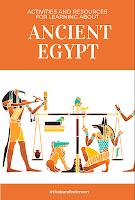One of my favorite history topics is ancient Egypt. The ancient Egyptians were such an interesting and artistic culture. I've always been amazed by their advanced architecture and beautiful art work. In this post I share some fun hands on activities and resources for learning about ancient Egypt.
Build A Pyramid
The ancient Egyptian pyramids are always a fascinating topic to study. It's amazing that they were able to build such massive and perfect structures without modern construction tools and vehicles. Here are a few resources for learning about the pyramids:
-Ancient Egypt-The Pyramids from Ducksters
-Egyptian Pyramids from History For Kids
-Are We There Yet? Egypt-Pyramids from NatGeoKids
-Destination- Egypt, Pyramids from National Geographic
After your child has learned about the pyramids, try building your own! We've done this project with Legos and with sugar cubes and glue.
Make Egyptian Pottery
The ancient Egyptians made some beautiful pottery. Spend some time looking at pictures and watching a few videos about ancient Egyptian pottery. Then grab some clay and paint and have your child try making their own Egyptian style pottery.
Here are a few videos and other resources about ancient Egyptian pottery:
-Ancient Egyptian Pottery from about Egypt
-Ancient Egyptian Pottery by Duncan Hall
-Egyptian Pottery from History For Kids
Make Hieroglyphics
The ancient Egyptians were one of the first cultures to develop a writing system. Spend a day learning about Egyptian hieroglyphics with these resources:
-Egyptian Hieroglyphics from Susan Euler
-Ancient Egypt- Hieroglyphics from Ducksters
-Fascinating Facts About Hieroglyphics! from NatGeoKids
Then have your child try writing their name or even a whole message in hieroglyphics with this Hieroglyphic Name Translator.
Learn About The Nile River
The Nile River provided the ancient Egyptians with water, animals for food, fertile soil, and many other important resources. Without it, it is doubtful the ancient Egyptians would have become such an advanced and flourishing society.
Spend some time teaching your kids about the Nile River and the wildlife it supported. Here are some great online resources about the Nile River, it's wildlife, and it's importance to the ancient Egyptians:
-Ancient Egypt- Geography And The Nile River from Ducksters
-Plants And Animals Of The Nile from The Royal Ontario Museum
Make A Mummy
Mummies are always an interesting topic to learn about. Check out these great resources about Egyptian mummies:
-How To Make A Mummy from NatGeoKids
-Mummification (How an Ancient Egyptian Mummy Was Made) from Simple History
-Are We There Yet: Egypt-Mummies from Travel Kids
Then try making your own mummy! You can try it with a real chicken with these instructions from Adventures In Mommydom, or if you prefer to mummify a rubber chicken, try this method from Creekside Learning.
If you enjoyed this post, check out:
-Learning About The California Gold Rush
-How We Teach Geography Without A Curriculum
Follow me on:
Facebook
Pinterest
Instagram
The ancient Egyptian pyramids are always a fascinating topic to study. It's amazing that they were able to build such massive and perfect structures without modern construction tools and vehicles. Here are a few resources for learning about the pyramids:
-Ancient Egypt-The Pyramids from Ducksters
-Egyptian Pyramids from History For Kids
-Are We There Yet? Egypt-Pyramids from NatGeoKids
-Destination- Egypt, Pyramids from National Geographic
After your child has learned about the pyramids, try building your own! We've done this project with Legos and with sugar cubes and glue.
Make Egyptian Pottery
The ancient Egyptians made some beautiful pottery. Spend some time looking at pictures and watching a few videos about ancient Egyptian pottery. Then grab some clay and paint and have your child try making their own Egyptian style pottery.
Here are a few videos and other resources about ancient Egyptian pottery:
-Ancient Egyptian Pottery from about Egypt
-Ancient Egyptian Pottery by Duncan Hall
-Egyptian Pottery from History For Kids
Make Hieroglyphics
The ancient Egyptians were one of the first cultures to develop a writing system. Spend a day learning about Egyptian hieroglyphics with these resources:
-Egyptian Hieroglyphics from Susan Euler
-Ancient Egypt- Hieroglyphics from Ducksters
-Fascinating Facts About Hieroglyphics! from NatGeoKids
Then have your child try writing their name or even a whole message in hieroglyphics with this Hieroglyphic Name Translator.
Learn About The Nile River
The Nile River provided the ancient Egyptians with water, animals for food, fertile soil, and many other important resources. Without it, it is doubtful the ancient Egyptians would have become such an advanced and flourishing society.
Spend some time teaching your kids about the Nile River and the wildlife it supported. Here are some great online resources about the Nile River, it's wildlife, and it's importance to the ancient Egyptians:
-Ancient Egypt- Geography And The Nile River from Ducksters
-Plants And Animals Of The Nile from The Royal Ontario Museum
Make A Mummy
Mummies are always an interesting topic to learn about. Check out these great resources about Egyptian mummies:
-How To Make A Mummy from NatGeoKids
-Mummification (How an Ancient Egyptian Mummy Was Made) from Simple History
-Are We There Yet: Egypt-Mummies from Travel Kids
Then try making your own mummy! You can try it with a real chicken with these instructions from Adventures In Mommydom, or if you prefer to mummify a rubber chicken, try this method from Creekside Learning.
If you enjoyed this post, check out:
-Learning About The California Gold Rush
-How We Teach Geography Without A Curriculum
Follow me on:







So much fun! We had lots of fun learning about Ancient Egypt (a couple of times through the years). Pinned.
ReplyDelete